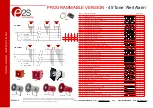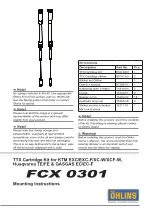
10-23
The sensitivity and detection limit of SCP are similar to those of DC polarography (5
µ
A/mM and 10
-5
M). The major advantage of SCP over D.C. polarography is the
smoothed current output, which facilitates measurement of the half-wave potentials
and limiting currents.
Although this is a essentially a polarographic technique, it can be used as a slow scan
rate voltammetry technique. This modification is often called "staircase"
voltammetry.
The potential wave form for Normal Pulse Voltammetry/Polarography (NPV/P) is
shown in Figure 10-12, and consists of a series of pulses of increasing amplitude,
with the potential returning to the initial value in between the pulses.
E
SAMPLE
WIDTH
PULSE WIDTH
PULSE PERIOD
QUIET
TIME
E
∆
t
Figure 10-12. Potential wave form for NPV/P.
Consider a reduction. If Initial E is well positive of the redox potential, the
application of small amplitude pulses does not cause any faradaic reaction, so there is
no faradaic current response. When the pulse amplitude is sufficiently large that the
pulsed potential is around the redox potential, there is a faradaic reaction in response
to the pulse (assuming moderately rapid electron transfer kinetics), and the magnitude
of this faradaic current may depend on both the rate of diffusion and the rate of
electron transfer. When the pulsed potentials are sufficiently negative of the redox
potential that the electron transfer occurs rapidly, the faradaic current depends only of
the rate of diffusion; that is, a limiting current has been reached. This current
response is shown in Figure 10-13. The sigmoidal shape is similar to the shape of the
curve obtained in the classical polarography experiment, which gives rise to the name
of normal for this pulse technique. The limiting current for NPV/P is greater than that
for SCP, and is therefore a more sensitive technique (30
µ
A/mM) and has a lower
detection limit (10
-6
M).
There is a variation of this technique called Reverse Pulse Voltammetry/Polarography
(RPV/P). In NPV/P, the initial potential is at a value at which no faradaic reaction
occurs, whereas in RPV/P, the initial potential is at a value at which the faradaic
















































